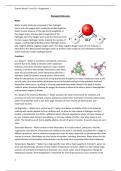Osman Yousuf – Unit 10 – Assignment 1
Biological Molecules
Water
Water is polar molecule composed of two hydrogen
atoms and one oxygen atom covalently bonded together.
Water is polar because of the high electronegativity of
the oxygen atom, and low electronegativity of the
hydrogen atom, the oxygen atom pulls the electrons from
the two oxygen-hydrogen bonds, towards the nucleus of
oxygen, creating slightly (Delta) positive hydrogen atoms,
and a slightly (Delta) negative oxygen atom. The delta negative Oxygen atom of one molecule is
attracted to the delta positive hydrogen atom of another water molecule, this interaction between
water molecules creates hydrogen bonds.
Functions
As a Solvent – Water is sometimes considered a universal
solvent due to its ability to dissolve other substances
(solutes), more than any other liquid can. Due to waters
polarity, it can form electrostatic interactions, with other
polar ions and molecules, these interactions allow for a
hydration shell (3D sphere) around solutes, these shells
allow for the particles of solute to be evenly distributed throughout in water. Substances such as oils
are not polar, thus electrostatic attractions cannot be formed and hence why hydration shell and
dispersion cannot occur, resulting in oil being separated from water. Blood in the body is mostly
made of water, therefore allowing for oxygen to dissolve in blood to be able to bind to haemoglobin
and transport oxygen to tissues.
As a Medium for Chemical Reactions – Water provides the ideal environment for reactions and
processes to occur, for example enzymes (proteins) conduct their mechanism of action within water,
water has properties such as can store large amounts of heat, neutral pH (when pure), and
electrically neutral.
pH Regulation – Water has a neutral pH of 7, water contributes to stability of pH in the blood by
reacting with carbon dioxide to form carbonic acid, to allow for the release of hydrogen ions(H+)
(acidic) or bicarbonate ions (HCO3-) (Alkaline) which allow to regulate the pH by increase release of
H+ ions in blood when blood is too alkaline, or increase release of HCO 3- ions when blood is too
acidic. The blood has a pH that is slightly alkaline, the pH of water is neutral, these pH values are very
close.
Electrolyte Balance – Water contains many electrolytes to include sodium, potassium, chloride,
magnesium, and calcium. Electrolytes are needed as the body is constantly using them for a range of
different processes, such as sodium and potassium used for action potential, to spread impulses from
neuron to neuron. Electrolytes are also lost by micturition, vomiting, diarrhoea. Water allows for the
replenishment and restoration of electrolytes into the body, thus preventing electrolyte imbalance.
Temperature Regulator – Water has a high specific heat, with a heat capacity of 4.18 J/g°C, water can
store and absorb large amounts of heat, before temperature increases. Water can also release large
amounts of heat before temperature decreases. As a result, water resists temperature change for
heating and cooling. Thermoregulation is important for normal processes to occur, enzymes in the
1
, Osman Yousuf – Unit 10 – Assignment 1
body work in specific temperatures, when the temperature is too high enzymes denature, and when
too low, enzymes do not function effectively and efficiently.
Cohesion-Tension – Water has cohesive
properties as the molecules have a tendency
to be attracted to each other. Water has
cohesive forces due to their ability to form
hydrogen bonds. Cohesion will allow for
surface tension, where the surface of water
is placed under stress or tension yet resists
rupture. When water is filled in a glass
completely to the top, adding more drops creates a dome shape by cohesion, and the water
molecules on the top that is exposed to air on one side will have less molecules to form hydrogen
bonds with, and thus the hydrogen bonds water molecules have at the surface are much more
stronger than water hydrogen bonding deeper within the liquid. The strong hydrogen bonds create a
surface film. This can also be exemplified with still bodies of water. Cohesion-tension therefore
supports very small objects when placed on top of water carefully and appropriately, hence why a
needle can float, or an insect can walk across water.
Adhesion – Water can also be attracted to different
substances and make hydrogen bonds with them such as
plant tissues. Water has adhesive properties as shown when
it sticks to the walls of xylem in plants to allow water to
ascend the plant and leave – transpiration. Adhesion causes
capillary action, where water molecules ‘pull’ each other to
give it the ability to ‘climb’ structures. For example, when
water ‘climbs’ up a glass tube because water is more
attracted to polar glass molecules than to other water
molecules. In the body, the blood is made mostly of water, and thus there will be adhesion to
epithelium in veins or arteries for blood
movement.
Carbohydrates
Carbohydrates are molecules made of carbon,
hydrogen and oxygen atoms. With a formula of
C(H2O)n It has a ratio of one carbon atom to
one water molecule. The length of the chain
determines what carbohydrate it is.
There are three classifications –
Monosaccharides, Disaccharides, and
Polysaccharides.
Monosaccharides are single carbohydrate molecules that cannot be further hydrolysed, it is known
as simple sugars (monomers), such as glucose, fructose, and galactose.
Disaccharides are two monosaccharides bonded together by the elimination of one water molecule.
This is known as a dehydration/condensation reaction. The link between the two monosaccharides in
a disaccharide is called a glycosidic bond. Some examples of disaccharides include maltose, sucrose,
and lactose.
2




